Managing Finance, HR, and Legal Aspects in Hospitality Report
VerifiedAdded on 2023/01/13
|13
|2573
|69
Report
AI Summary
This report provides a comprehensive analysis of key management principles within the hospitality industry, focusing on Carnival Corporation & plc. It delves into financial management, including transaction recording, cost minimization, and the use of double-entry bookkeeping. The report assesses human resource management, covering the HR lifecycle from recruitment to employee retention, with emphasis on performance management and training. Furthermore, it illustrates the potential impact of legal and ethical considerations, such as environmental, food safety, and consumer legislation, on a hospitality business. The report examines financial performance indicators, budgeting, and the importance of adhering to legal and ethical standards to ensure sustainable business practices. The report also includes detailed examples such as the sales and food accounting ledgers. The report provides insights into the interconnectedness of various operational and functional departments within the business context.
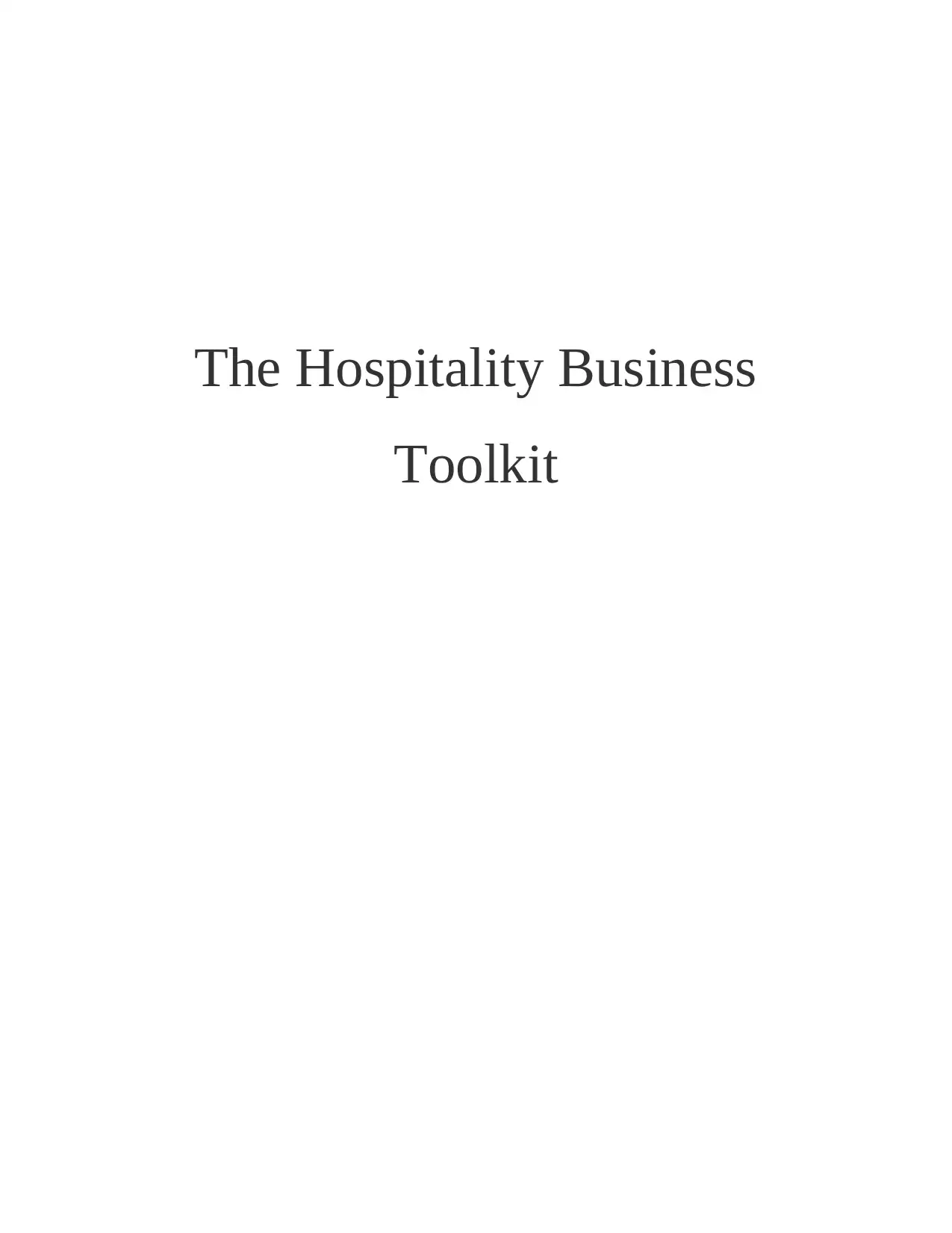
The Hospitality Business
Toolkit
Toolkit
Paraphrase This Document
Need a fresh take? Get an instant paraphrase of this document with our AI Paraphraser
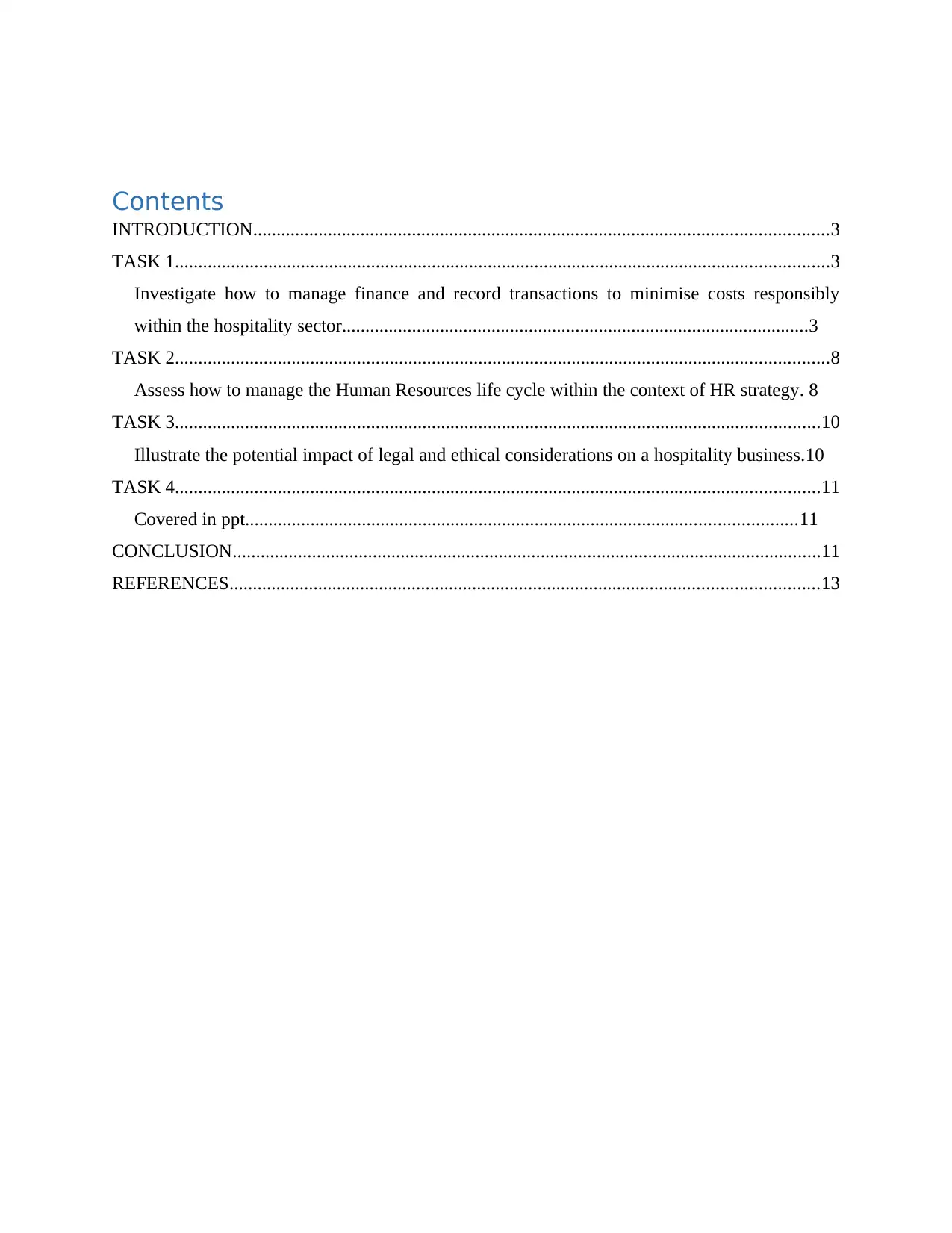
Contents
INTRODUCTION...........................................................................................................................3
TASK 1............................................................................................................................................3
Investigate how to manage finance and record transactions to minimise costs responsibly
within the hospitality sector....................................................................................................3
TASK 2............................................................................................................................................8
Assess how to manage the Human Resources life cycle within the context of HR strategy. 8
TASK 3..........................................................................................................................................10
Illustrate the potential impact of legal and ethical considerations on a hospitality business.10
TASK 4..........................................................................................................................................11
Covered in ppt......................................................................................................................11
CONCLUSION..............................................................................................................................11
REFERENCES..............................................................................................................................13
INTRODUCTION...........................................................................................................................3
TASK 1............................................................................................................................................3
Investigate how to manage finance and record transactions to minimise costs responsibly
within the hospitality sector....................................................................................................3
TASK 2............................................................................................................................................8
Assess how to manage the Human Resources life cycle within the context of HR strategy. 8
TASK 3..........................................................................................................................................10
Illustrate the potential impact of legal and ethical considerations on a hospitality business.10
TASK 4..........................................................................................................................................11
Covered in ppt......................................................................................................................11
CONCLUSION..............................................................................................................................11
REFERENCES..............................................................................................................................13
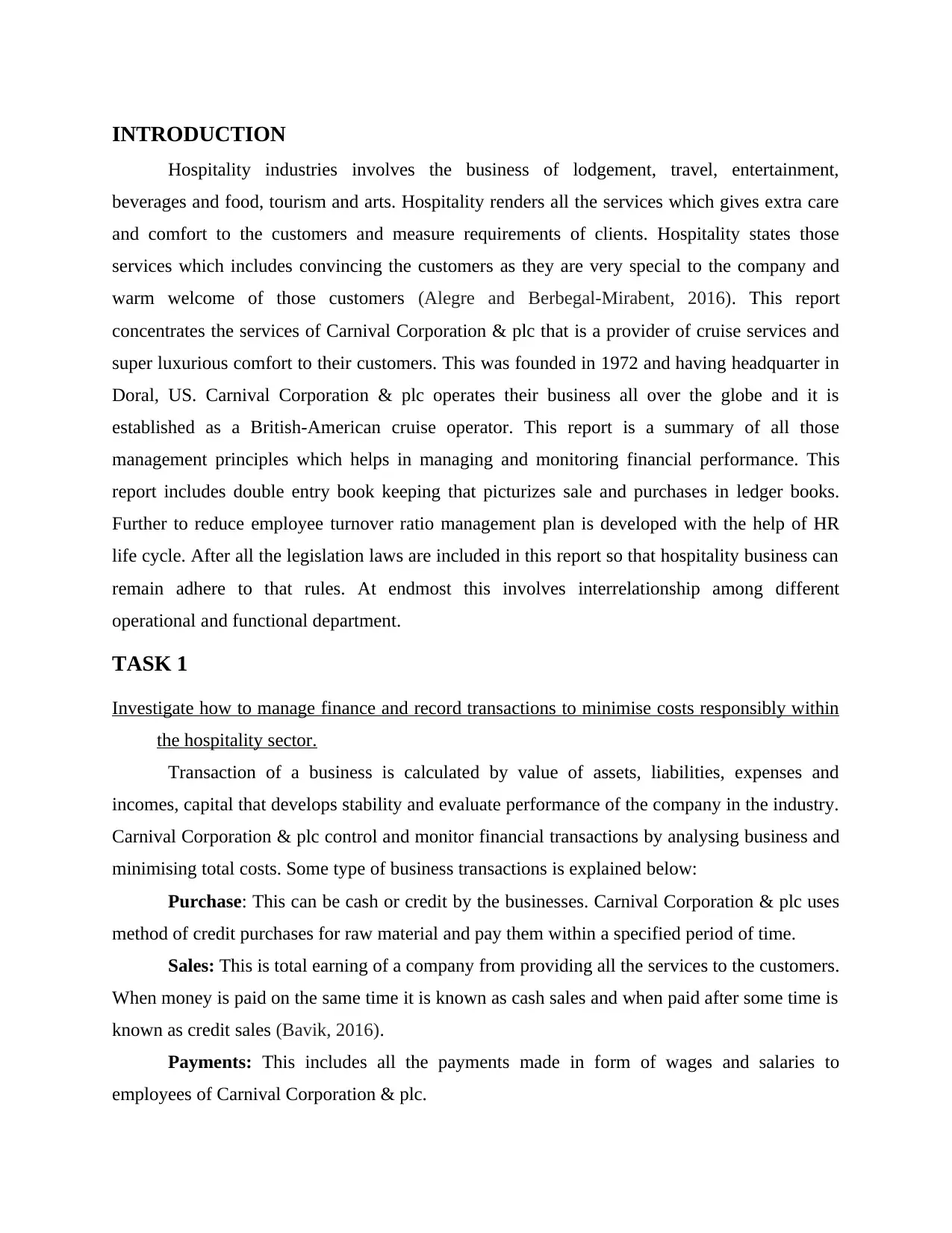
INTRODUCTION
Hospitality industries involves the business of lodgement, travel, entertainment,
beverages and food, tourism and arts. Hospitality renders all the services which gives extra care
and comfort to the customers and measure requirements of clients. Hospitality states those
services which includes convincing the customers as they are very special to the company and
warm welcome of those customers (Alegre and Berbegal-Mirabent, 2016). This report
concentrates the services of Carnival Corporation & plc that is a provider of cruise services and
super luxurious comfort to their customers. This was founded in 1972 and having headquarter in
Doral, US. Carnival Corporation & plc operates their business all over the globe and it is
established as a British-American cruise operator. This report is a summary of all those
management principles which helps in managing and monitoring financial performance. This
report includes double entry book keeping that picturizes sale and purchases in ledger books.
Further to reduce employee turnover ratio management plan is developed with the help of HR
life cycle. After all the legislation laws are included in this report so that hospitality business can
remain adhere to that rules. At endmost this involves interrelationship among different
operational and functional department.
TASK 1
Investigate how to manage finance and record transactions to minimise costs responsibly within
the hospitality sector.
Transaction of a business is calculated by value of assets, liabilities, expenses and
incomes, capital that develops stability and evaluate performance of the company in the industry.
Carnival Corporation & plc control and monitor financial transactions by analysing business and
minimising total costs. Some type of business transactions is explained below:
Purchase: This can be cash or credit by the businesses. Carnival Corporation & plc uses
method of credit purchases for raw material and pay them within a specified period of time.
Sales: This is total earning of a company from providing all the services to the customers.
When money is paid on the same time it is known as cash sales and when paid after some time is
known as credit sales (Bavik, 2016).
Payments: This includes all the payments made in form of wages and salaries to
employees of Carnival Corporation & plc.
Hospitality industries involves the business of lodgement, travel, entertainment,
beverages and food, tourism and arts. Hospitality renders all the services which gives extra care
and comfort to the customers and measure requirements of clients. Hospitality states those
services which includes convincing the customers as they are very special to the company and
warm welcome of those customers (Alegre and Berbegal-Mirabent, 2016). This report
concentrates the services of Carnival Corporation & plc that is a provider of cruise services and
super luxurious comfort to their customers. This was founded in 1972 and having headquarter in
Doral, US. Carnival Corporation & plc operates their business all over the globe and it is
established as a British-American cruise operator. This report is a summary of all those
management principles which helps in managing and monitoring financial performance. This
report includes double entry book keeping that picturizes sale and purchases in ledger books.
Further to reduce employee turnover ratio management plan is developed with the help of HR
life cycle. After all the legislation laws are included in this report so that hospitality business can
remain adhere to that rules. At endmost this involves interrelationship among different
operational and functional department.
TASK 1
Investigate how to manage finance and record transactions to minimise costs responsibly within
the hospitality sector.
Transaction of a business is calculated by value of assets, liabilities, expenses and
incomes, capital that develops stability and evaluate performance of the company in the industry.
Carnival Corporation & plc control and monitor financial transactions by analysing business and
minimising total costs. Some type of business transactions is explained below:
Purchase: This can be cash or credit by the businesses. Carnival Corporation & plc uses
method of credit purchases for raw material and pay them within a specified period of time.
Sales: This is total earning of a company from providing all the services to the customers.
When money is paid on the same time it is known as cash sales and when paid after some time is
known as credit sales (Bavik, 2016).
Payments: This includes all the payments made in form of wages and salaries to
employees of Carnival Corporation & plc.
⊘ This is a preview!⊘
Do you want full access?
Subscribe today to unlock all pages.

Trusted by 1+ million students worldwide
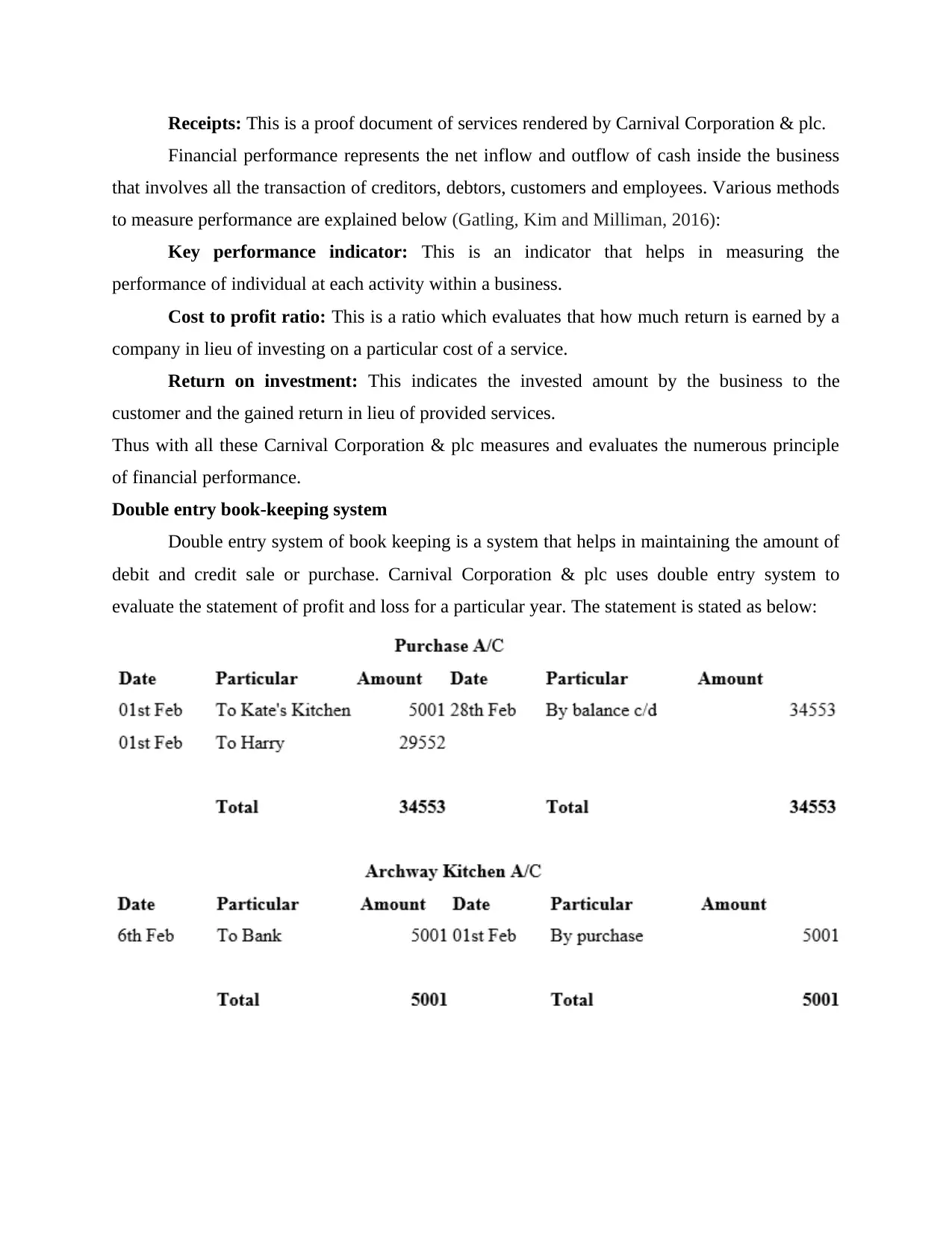
Receipts: This is a proof document of services rendered by Carnival Corporation & plc.
Financial performance represents the net inflow and outflow of cash inside the business
that involves all the transaction of creditors, debtors, customers and employees. Various methods
to measure performance are explained below (Gatling, Kim and Milliman, 2016):
Key performance indicator: This is an indicator that helps in measuring the
performance of individual at each activity within a business.
Cost to profit ratio: This is a ratio which evaluates that how much return is earned by a
company in lieu of investing on a particular cost of a service.
Return on investment: This indicates the invested amount by the business to the
customer and the gained return in lieu of provided services.
Thus with all these Carnival Corporation & plc measures and evaluates the numerous principle
of financial performance.
Double entry book-keeping system
Double entry system of book keeping is a system that helps in maintaining the amount of
debit and credit sale or purchase. Carnival Corporation & plc uses double entry system to
evaluate the statement of profit and loss for a particular year. The statement is stated as below:
Financial performance represents the net inflow and outflow of cash inside the business
that involves all the transaction of creditors, debtors, customers and employees. Various methods
to measure performance are explained below (Gatling, Kim and Milliman, 2016):
Key performance indicator: This is an indicator that helps in measuring the
performance of individual at each activity within a business.
Cost to profit ratio: This is a ratio which evaluates that how much return is earned by a
company in lieu of investing on a particular cost of a service.
Return on investment: This indicates the invested amount by the business to the
customer and the gained return in lieu of provided services.
Thus with all these Carnival Corporation & plc measures and evaluates the numerous principle
of financial performance.
Double entry book-keeping system
Double entry system of book keeping is a system that helps in maintaining the amount of
debit and credit sale or purchase. Carnival Corporation & plc uses double entry system to
evaluate the statement of profit and loss for a particular year. The statement is stated as below:
Paraphrase This Document
Need a fresh take? Get an instant paraphrase of this document with our AI Paraphraser
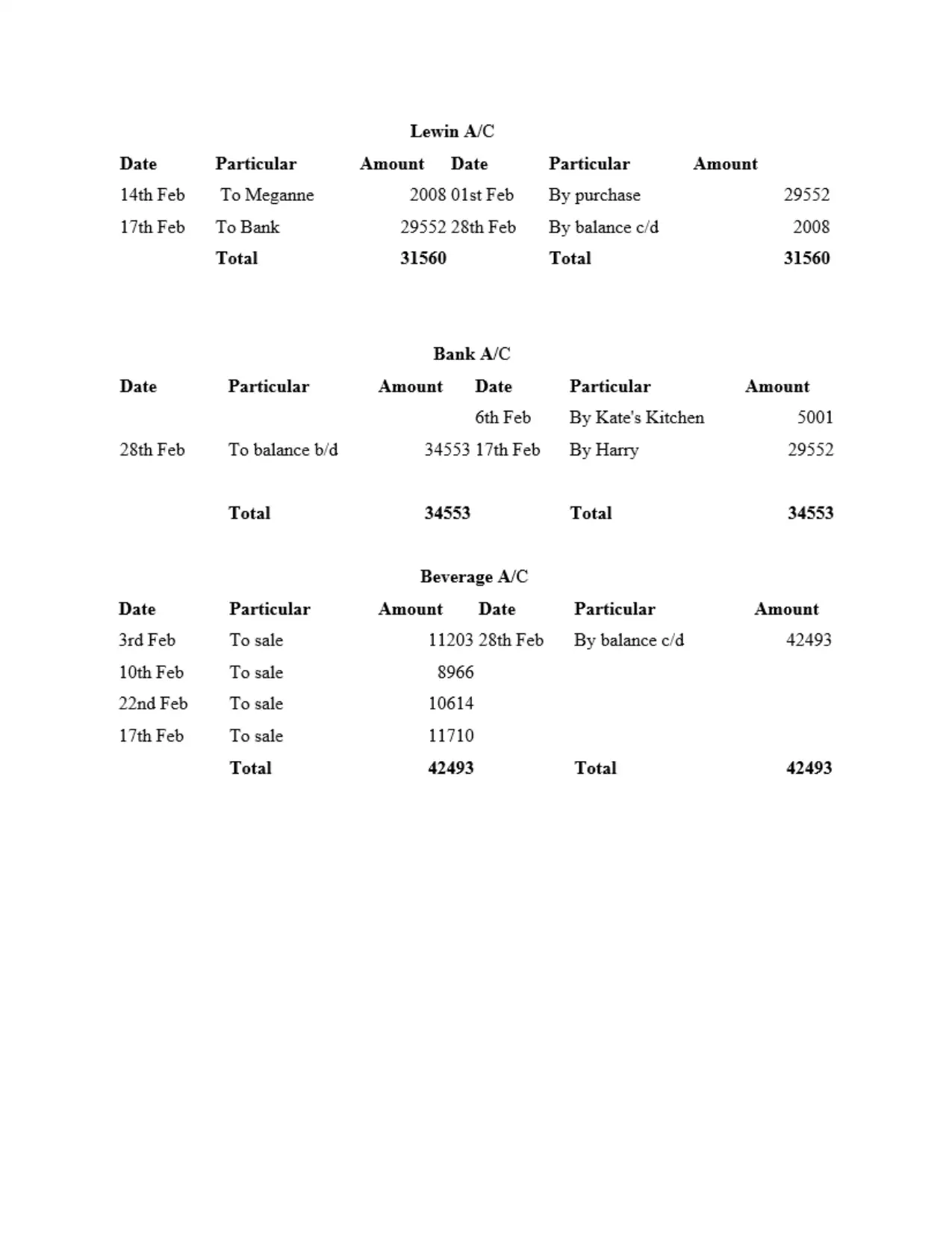
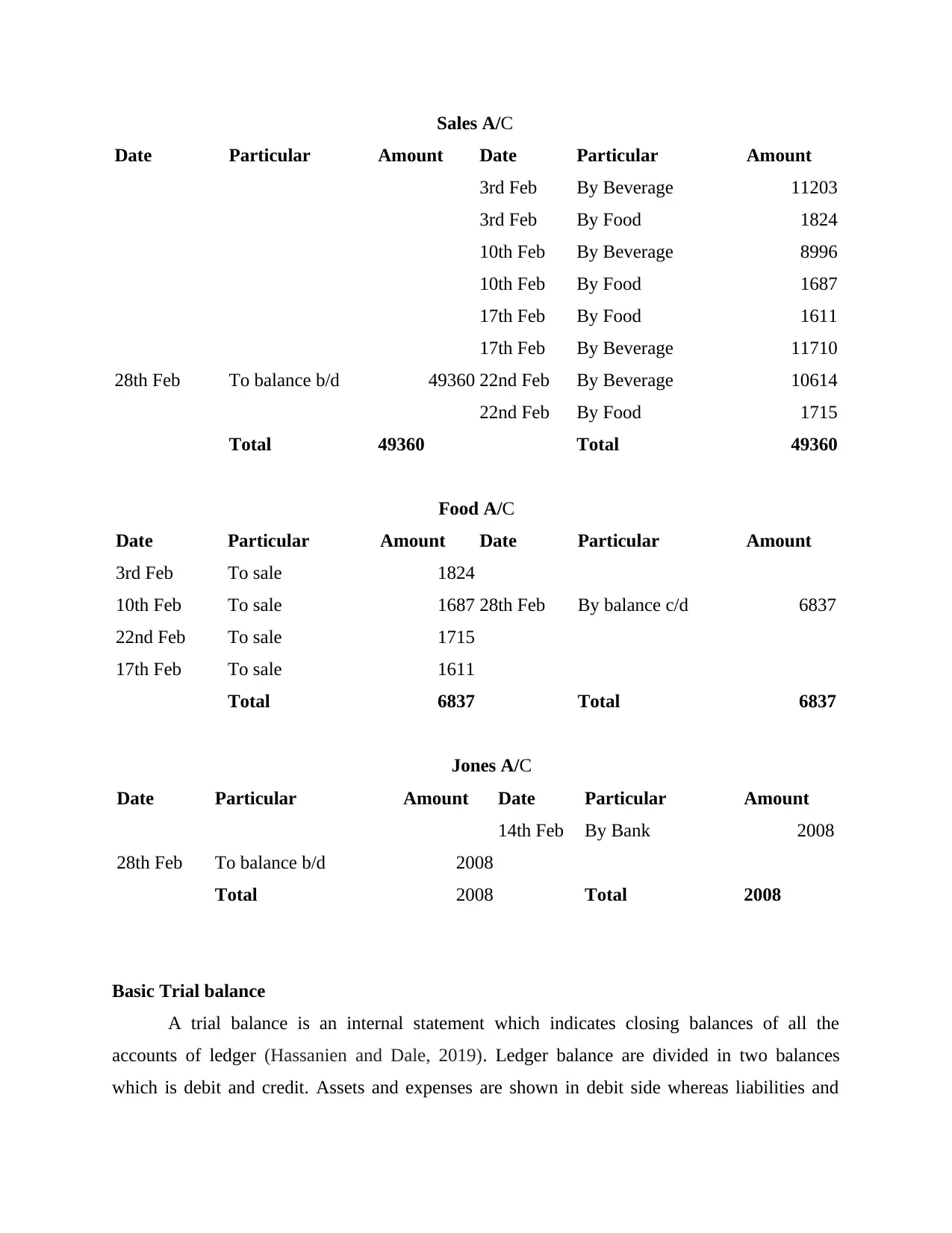
Sales A/C
Date Particular Amount Date Particular Amount
3rd Feb By Beverage 11203
3rd Feb By Food 1824
10th Feb By Beverage 8996
10th Feb By Food 1687
17th Feb By Food 1611
17th Feb By Beverage 11710
28th Feb To balance b/d 49360 22nd Feb By Beverage 10614
22nd Feb By Food 1715
Total 49360 Total 49360
Food A/C
Date Particular Amount Date Particular Amount
3rd Feb To sale 1824
10th Feb To sale 1687 28th Feb By balance c/d 6837
22nd Feb To sale 1715
17th Feb To sale 1611
Total 6837 Total 6837
Jones A/C
Date Particular Amount Date Particular Amount
14th Feb By Bank 2008
28th Feb To balance b/d 2008
Total 2008 Total 2008
Basic Trial balance
A trial balance is an internal statement which indicates closing balances of all the
accounts of ledger (Hassanien and Dale, 2019). Ledger balance are divided in two balances
which is debit and credit. Assets and expenses are shown in debit side whereas liabilities and
Date Particular Amount Date Particular Amount
3rd Feb By Beverage 11203
3rd Feb By Food 1824
10th Feb By Beverage 8996
10th Feb By Food 1687
17th Feb By Food 1611
17th Feb By Beverage 11710
28th Feb To balance b/d 49360 22nd Feb By Beverage 10614
22nd Feb By Food 1715
Total 49360 Total 49360
Food A/C
Date Particular Amount Date Particular Amount
3rd Feb To sale 1824
10th Feb To sale 1687 28th Feb By balance c/d 6837
22nd Feb To sale 1715
17th Feb To sale 1611
Total 6837 Total 6837
Jones A/C
Date Particular Amount Date Particular Amount
14th Feb By Bank 2008
28th Feb To balance b/d 2008
Total 2008 Total 2008
Basic Trial balance
A trial balance is an internal statement which indicates closing balances of all the
accounts of ledger (Hassanien and Dale, 2019). Ledger balance are divided in two balances
which is debit and credit. Assets and expenses are shown in debit side whereas liabilities and
⊘ This is a preview!⊘
Do you want full access?
Subscribe today to unlock all pages.

Trusted by 1+ million students worldwide
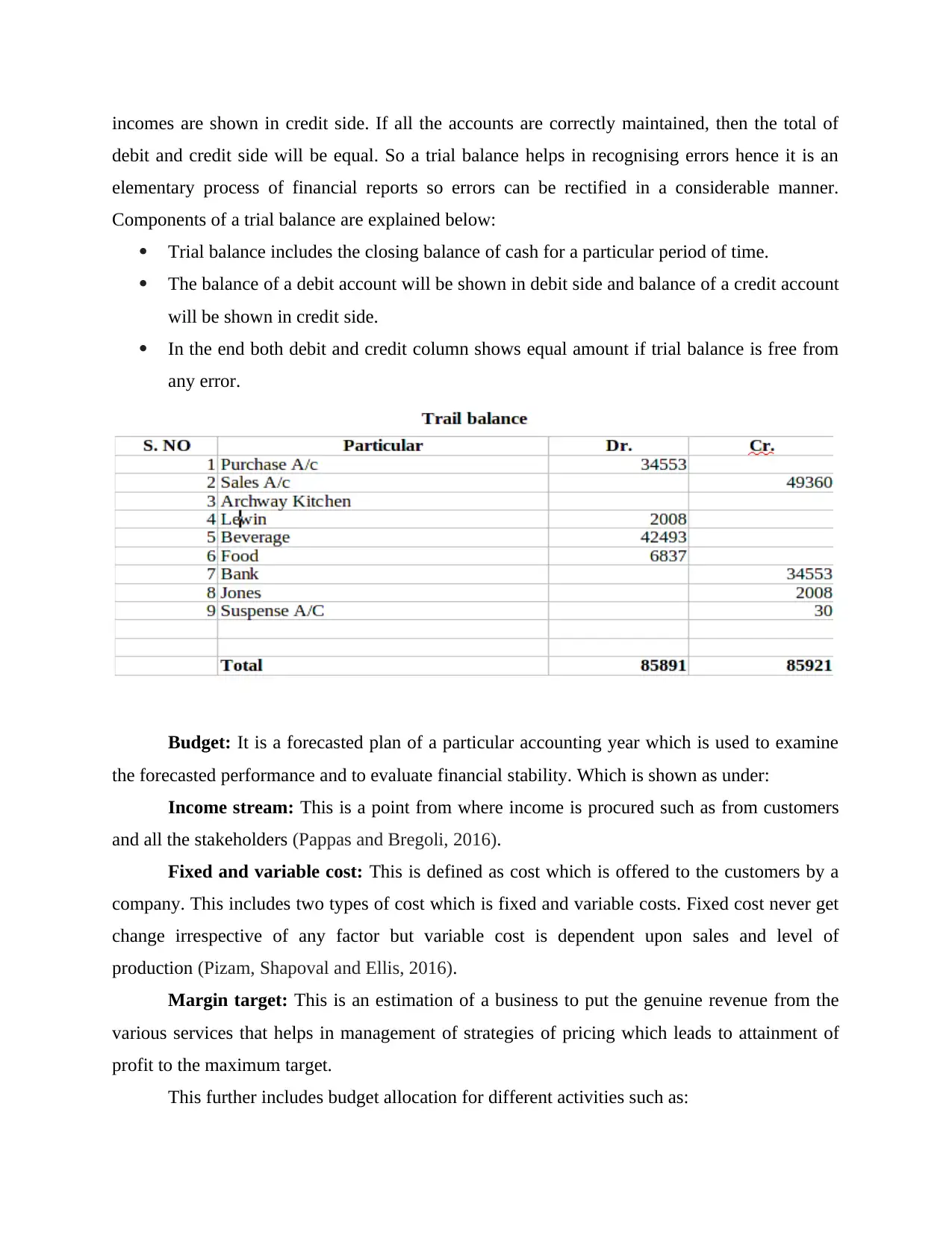
incomes are shown in credit side. If all the accounts are correctly maintained, then the total of
debit and credit side will be equal. So a trial balance helps in recognising errors hence it is an
elementary process of financial reports so errors can be rectified in a considerable manner.
Components of a trial balance are explained below:
Trial balance includes the closing balance of cash for a particular period of time.
The balance of a debit account will be shown in debit side and balance of a credit account
will be shown in credit side.
In the end both debit and credit column shows equal amount if trial balance is free from
any error.
Budget: It is a forecasted plan of a particular accounting year which is used to examine
the forecasted performance and to evaluate financial stability. Which is shown as under:
Income stream: This is a point from where income is procured such as from customers
and all the stakeholders (Pappas and Bregoli, 2016).
Fixed and variable cost: This is defined as cost which is offered to the customers by a
company. This includes two types of cost which is fixed and variable costs. Fixed cost never get
change irrespective of any factor but variable cost is dependent upon sales and level of
production (Pizam, Shapoval and Ellis, 2016).
Margin target: This is an estimation of a business to put the genuine revenue from the
various services that helps in management of strategies of pricing which leads to attainment of
profit to the maximum target.
This further includes budget allocation for different activities such as:
debit and credit side will be equal. So a trial balance helps in recognising errors hence it is an
elementary process of financial reports so errors can be rectified in a considerable manner.
Components of a trial balance are explained below:
Trial balance includes the closing balance of cash for a particular period of time.
The balance of a debit account will be shown in debit side and balance of a credit account
will be shown in credit side.
In the end both debit and credit column shows equal amount if trial balance is free from
any error.
Budget: It is a forecasted plan of a particular accounting year which is used to examine
the forecasted performance and to evaluate financial stability. Which is shown as under:
Income stream: This is a point from where income is procured such as from customers
and all the stakeholders (Pappas and Bregoli, 2016).
Fixed and variable cost: This is defined as cost which is offered to the customers by a
company. This includes two types of cost which is fixed and variable costs. Fixed cost never get
change irrespective of any factor but variable cost is dependent upon sales and level of
production (Pizam, Shapoval and Ellis, 2016).
Margin target: This is an estimation of a business to put the genuine revenue from the
various services that helps in management of strategies of pricing which leads to attainment of
profit to the maximum target.
This further includes budget allocation for different activities such as:
Paraphrase This Document
Need a fresh take? Get an instant paraphrase of this document with our AI Paraphraser
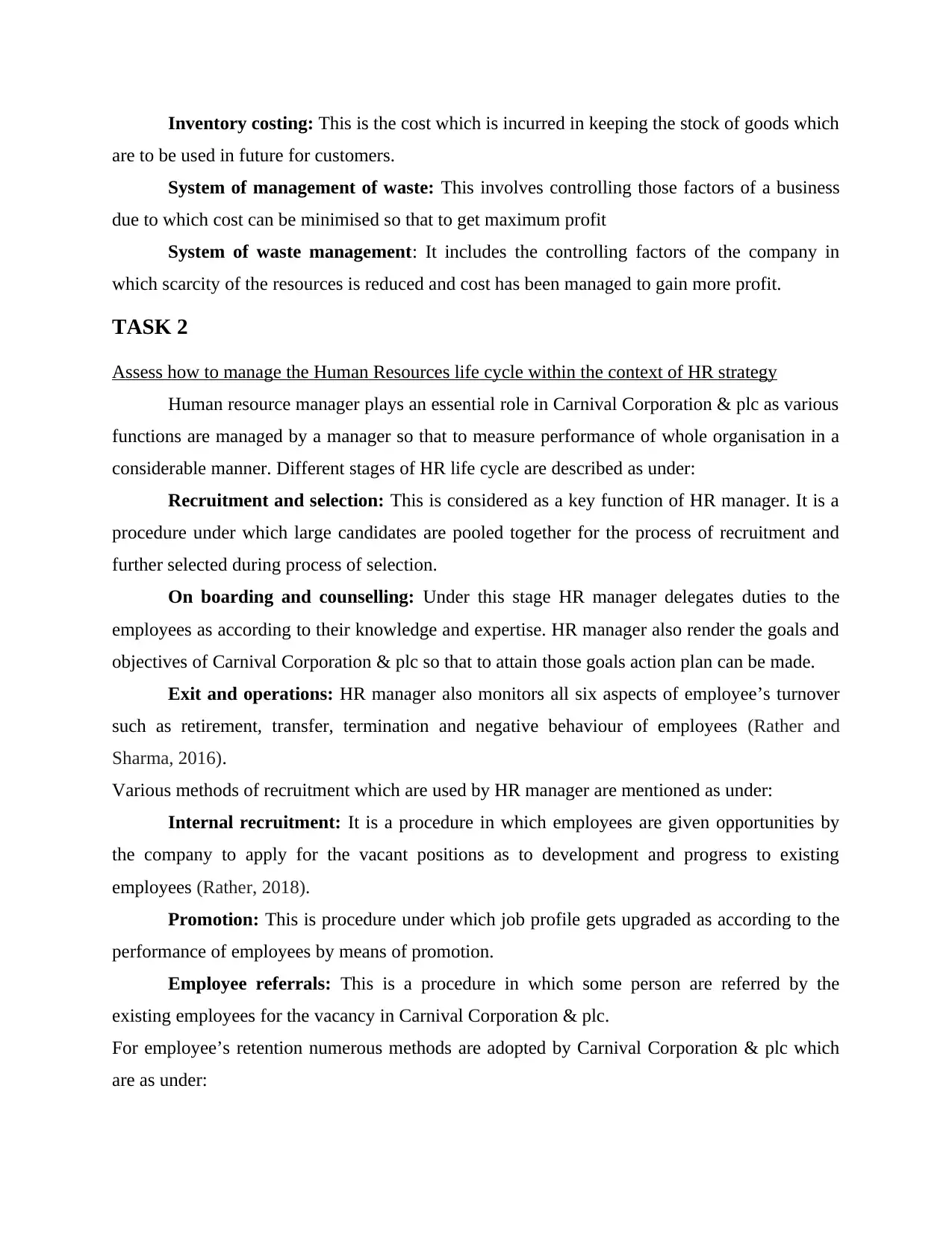
Inventory costing: This is the cost which is incurred in keeping the stock of goods which
are to be used in future for customers.
System of management of waste: This involves controlling those factors of a business
due to which cost can be minimised so that to get maximum profit
System of waste management: It includes the controlling factors of the company in
which scarcity of the resources is reduced and cost has been managed to gain more profit.
TASK 2
Assess how to manage the Human Resources life cycle within the context of HR strategy
Human resource manager plays an essential role in Carnival Corporation & plc as various
functions are managed by a manager so that to measure performance of whole organisation in a
considerable manner. Different stages of HR life cycle are described as under:
Recruitment and selection: This is considered as a key function of HR manager. It is a
procedure under which large candidates are pooled together for the process of recruitment and
further selected during process of selection.
On boarding and counselling: Under this stage HR manager delegates duties to the
employees as according to their knowledge and expertise. HR manager also render the goals and
objectives of Carnival Corporation & plc so that to attain those goals action plan can be made.
Exit and operations: HR manager also monitors all six aspects of employee’s turnover
such as retirement, transfer, termination and negative behaviour of employees (Rather and
Sharma, 2016).
Various methods of recruitment which are used by HR manager are mentioned as under:
Internal recruitment: It is a procedure in which employees are given opportunities by
the company to apply for the vacant positions as to development and progress to existing
employees (Rather, 2018).
Promotion: This is procedure under which job profile gets upgraded as according to the
performance of employees by means of promotion.
Employee referrals: This is a procedure in which some person are referred by the
existing employees for the vacancy in Carnival Corporation & plc.
For employee’s retention numerous methods are adopted by Carnival Corporation & plc which
are as under:
are to be used in future for customers.
System of management of waste: This involves controlling those factors of a business
due to which cost can be minimised so that to get maximum profit
System of waste management: It includes the controlling factors of the company in
which scarcity of the resources is reduced and cost has been managed to gain more profit.
TASK 2
Assess how to manage the Human Resources life cycle within the context of HR strategy
Human resource manager plays an essential role in Carnival Corporation & plc as various
functions are managed by a manager so that to measure performance of whole organisation in a
considerable manner. Different stages of HR life cycle are described as under:
Recruitment and selection: This is considered as a key function of HR manager. It is a
procedure under which large candidates are pooled together for the process of recruitment and
further selected during process of selection.
On boarding and counselling: Under this stage HR manager delegates duties to the
employees as according to their knowledge and expertise. HR manager also render the goals and
objectives of Carnival Corporation & plc so that to attain those goals action plan can be made.
Exit and operations: HR manager also monitors all six aspects of employee’s turnover
such as retirement, transfer, termination and negative behaviour of employees (Rather and
Sharma, 2016).
Various methods of recruitment which are used by HR manager are mentioned as under:
Internal recruitment: It is a procedure in which employees are given opportunities by
the company to apply for the vacant positions as to development and progress to existing
employees (Rather, 2018).
Promotion: This is procedure under which job profile gets upgraded as according to the
performance of employees by means of promotion.
Employee referrals: This is a procedure in which some person are referred by the
existing employees for the vacancy in Carnival Corporation & plc.
For employee’s retention numerous methods are adopted by Carnival Corporation & plc which
are as under:
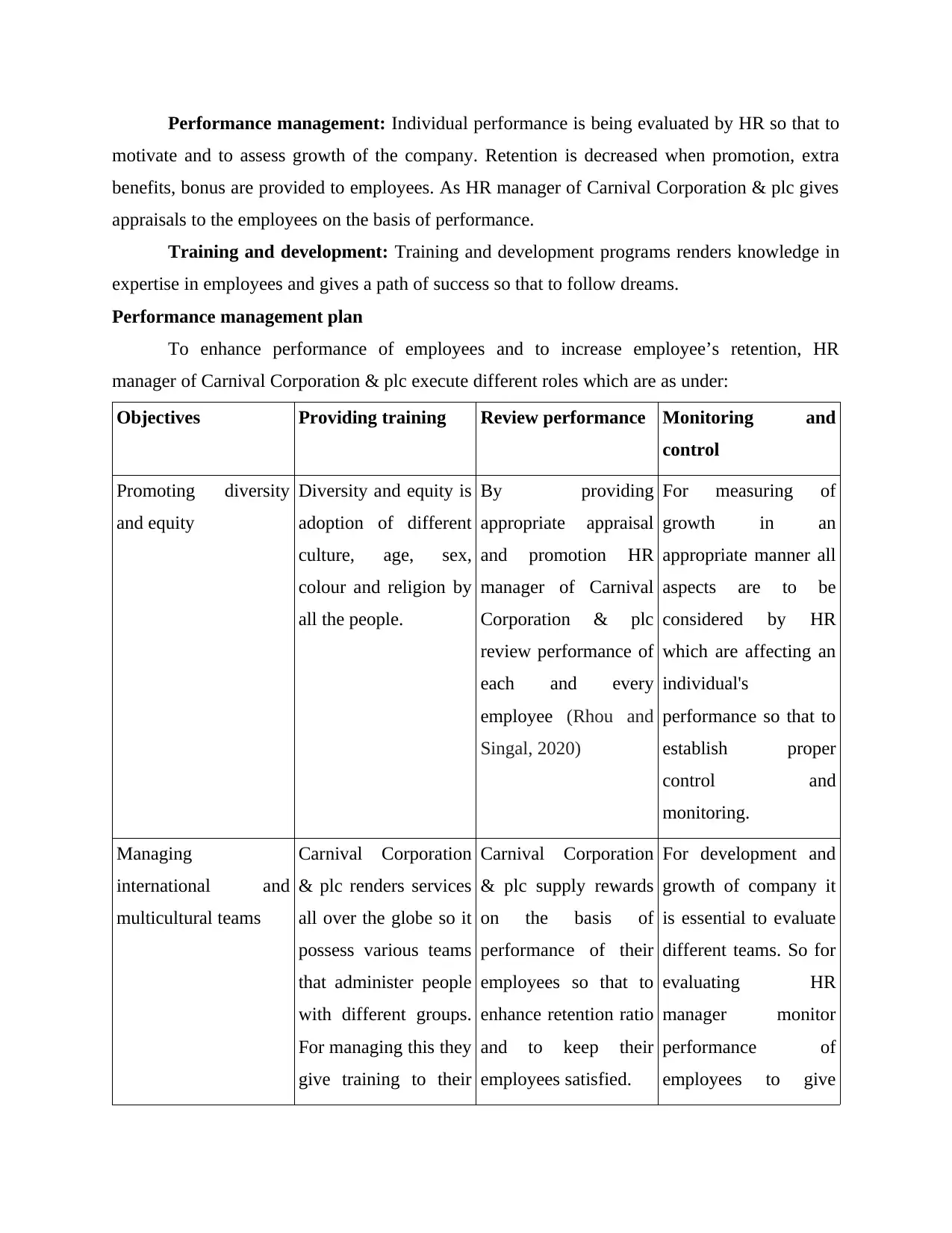
Performance management: Individual performance is being evaluated by HR so that to
motivate and to assess growth of the company. Retention is decreased when promotion, extra
benefits, bonus are provided to employees. As HR manager of Carnival Corporation & plc gives
appraisals to the employees on the basis of performance.
Training and development: Training and development programs renders knowledge in
expertise in employees and gives a path of success so that to follow dreams.
Performance management plan
To enhance performance of employees and to increase employee’s retention, HR
manager of Carnival Corporation & plc execute different roles which are as under:
Objectives Providing training Review performance Monitoring and
control
Promoting diversity
and equity
Diversity and equity is
adoption of different
culture, age, sex,
colour and religion by
all the people.
By providing
appropriate appraisal
and promotion HR
manager of Carnival
Corporation & plc
review performance of
each and every
employee (Rhou and
Singal, 2020)
For measuring of
growth in an
appropriate manner all
aspects are to be
considered by HR
which are affecting an
individual's
performance so that to
establish proper
control and
monitoring.
Managing
international and
multicultural teams
Carnival Corporation
& plc renders services
all over the globe so it
possess various teams
that administer people
with different groups.
For managing this they
give training to their
Carnival Corporation
& plc supply rewards
on the basis of
performance of their
employees so that to
enhance retention ratio
and to keep their
employees satisfied.
For development and
growth of company it
is essential to evaluate
different teams. So for
evaluating HR
manager monitor
performance of
employees to give
motivate and to assess growth of the company. Retention is decreased when promotion, extra
benefits, bonus are provided to employees. As HR manager of Carnival Corporation & plc gives
appraisals to the employees on the basis of performance.
Training and development: Training and development programs renders knowledge in
expertise in employees and gives a path of success so that to follow dreams.
Performance management plan
To enhance performance of employees and to increase employee’s retention, HR
manager of Carnival Corporation & plc execute different roles which are as under:
Objectives Providing training Review performance Monitoring and
control
Promoting diversity
and equity
Diversity and equity is
adoption of different
culture, age, sex,
colour and religion by
all the people.
By providing
appropriate appraisal
and promotion HR
manager of Carnival
Corporation & plc
review performance of
each and every
employee (Rhou and
Singal, 2020)
For measuring of
growth in an
appropriate manner all
aspects are to be
considered by HR
which are affecting an
individual's
performance so that to
establish proper
control and
monitoring.
Managing
international and
multicultural teams
Carnival Corporation
& plc renders services
all over the globe so it
possess various teams
that administer people
with different groups.
For managing this they
give training to their
Carnival Corporation
& plc supply rewards
on the basis of
performance of their
employees so that to
enhance retention ratio
and to keep their
employees satisfied.
For development and
growth of company it
is essential to evaluate
different teams. So for
evaluating HR
manager monitor
performance of
employees to give
⊘ This is a preview!⊘
Do you want full access?
Subscribe today to unlock all pages.

Trusted by 1+ million students worldwide
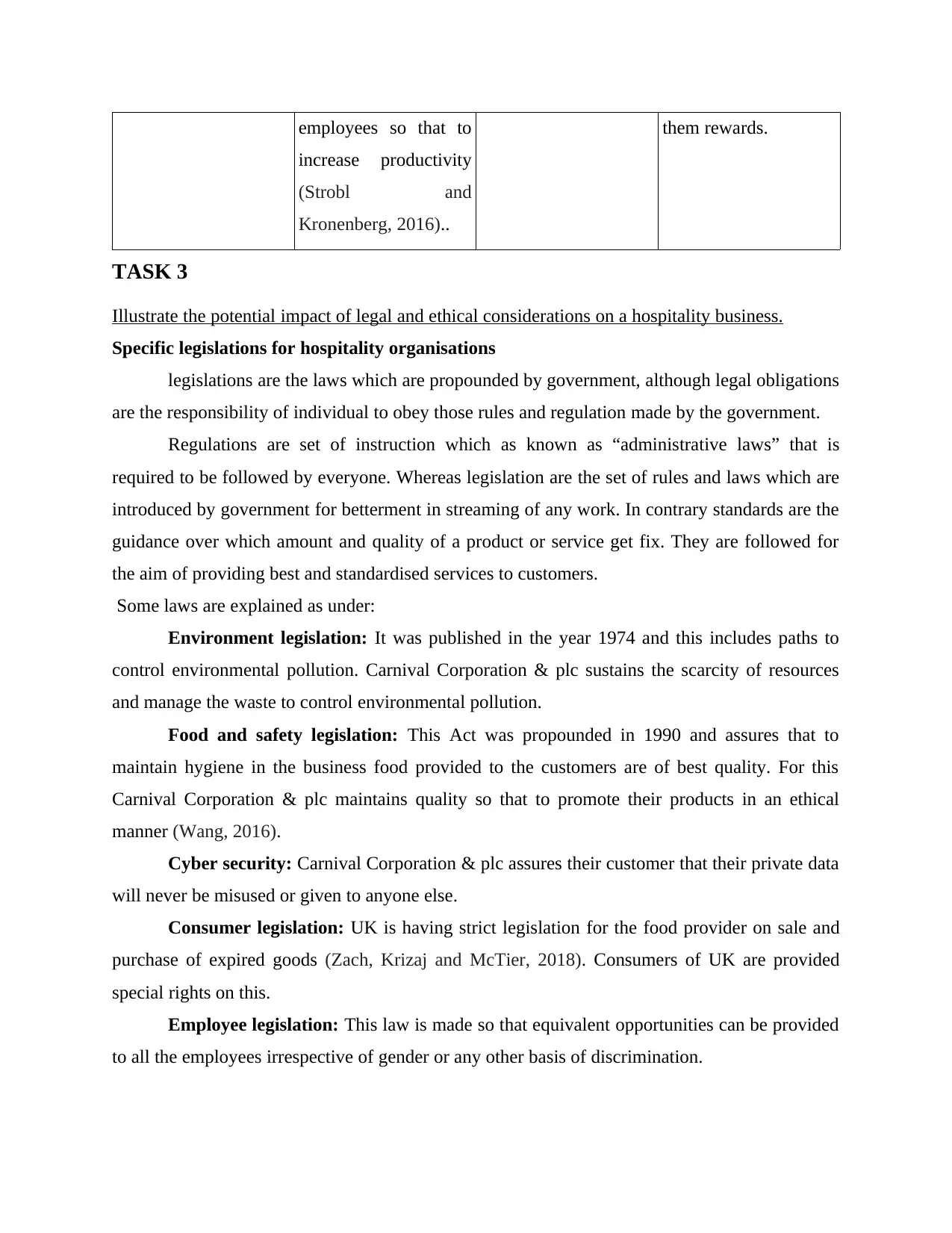
employees so that to
increase productivity
(Strobl and
Kronenberg, 2016)..
them rewards.
TASK 3
Illustrate the potential impact of legal and ethical considerations on a hospitality business.
Specific legislations for hospitality organisations
legislations are the laws which are propounded by government, although legal obligations
are the responsibility of individual to obey those rules and regulation made by the government.
Regulations are set of instruction which as known as “administrative laws” that is
required to be followed by everyone. Whereas legislation are the set of rules and laws which are
introduced by government for betterment in streaming of any work. In contrary standards are the
guidance over which amount and quality of a product or service get fix. They are followed for
the aim of providing best and standardised services to customers.
Some laws are explained as under:
Environment legislation: It was published in the year 1974 and this includes paths to
control environmental pollution. Carnival Corporation & plc sustains the scarcity of resources
and manage the waste to control environmental pollution.
Food and safety legislation: This Act was propounded in 1990 and assures that to
maintain hygiene in the business food provided to the customers are of best quality. For this
Carnival Corporation & plc maintains quality so that to promote their products in an ethical
manner (Wang, 2016).
Cyber security: Carnival Corporation & plc assures their customer that their private data
will never be misused or given to anyone else.
Consumer legislation: UK is having strict legislation for the food provider on sale and
purchase of expired goods (Zach, Krizaj and McTier, 2018). Consumers of UK are provided
special rights on this.
Employee legislation: This law is made so that equivalent opportunities can be provided
to all the employees irrespective of gender or any other basis of discrimination.
increase productivity
(Strobl and
Kronenberg, 2016)..
them rewards.
TASK 3
Illustrate the potential impact of legal and ethical considerations on a hospitality business.
Specific legislations for hospitality organisations
legislations are the laws which are propounded by government, although legal obligations
are the responsibility of individual to obey those rules and regulation made by the government.
Regulations are set of instruction which as known as “administrative laws” that is
required to be followed by everyone. Whereas legislation are the set of rules and laws which are
introduced by government for betterment in streaming of any work. In contrary standards are the
guidance over which amount and quality of a product or service get fix. They are followed for
the aim of providing best and standardised services to customers.
Some laws are explained as under:
Environment legislation: It was published in the year 1974 and this includes paths to
control environmental pollution. Carnival Corporation & plc sustains the scarcity of resources
and manage the waste to control environmental pollution.
Food and safety legislation: This Act was propounded in 1990 and assures that to
maintain hygiene in the business food provided to the customers are of best quality. For this
Carnival Corporation & plc maintains quality so that to promote their products in an ethical
manner (Wang, 2016).
Cyber security: Carnival Corporation & plc assures their customer that their private data
will never be misused or given to anyone else.
Consumer legislation: UK is having strict legislation for the food provider on sale and
purchase of expired goods (Zach, Krizaj and McTier, 2018). Consumers of UK are provided
special rights on this.
Employee legislation: This law is made so that equivalent opportunities can be provided
to all the employees irrespective of gender or any other basis of discrimination.
Paraphrase This Document
Need a fresh take? Get an instant paraphrase of this document with our AI Paraphraser
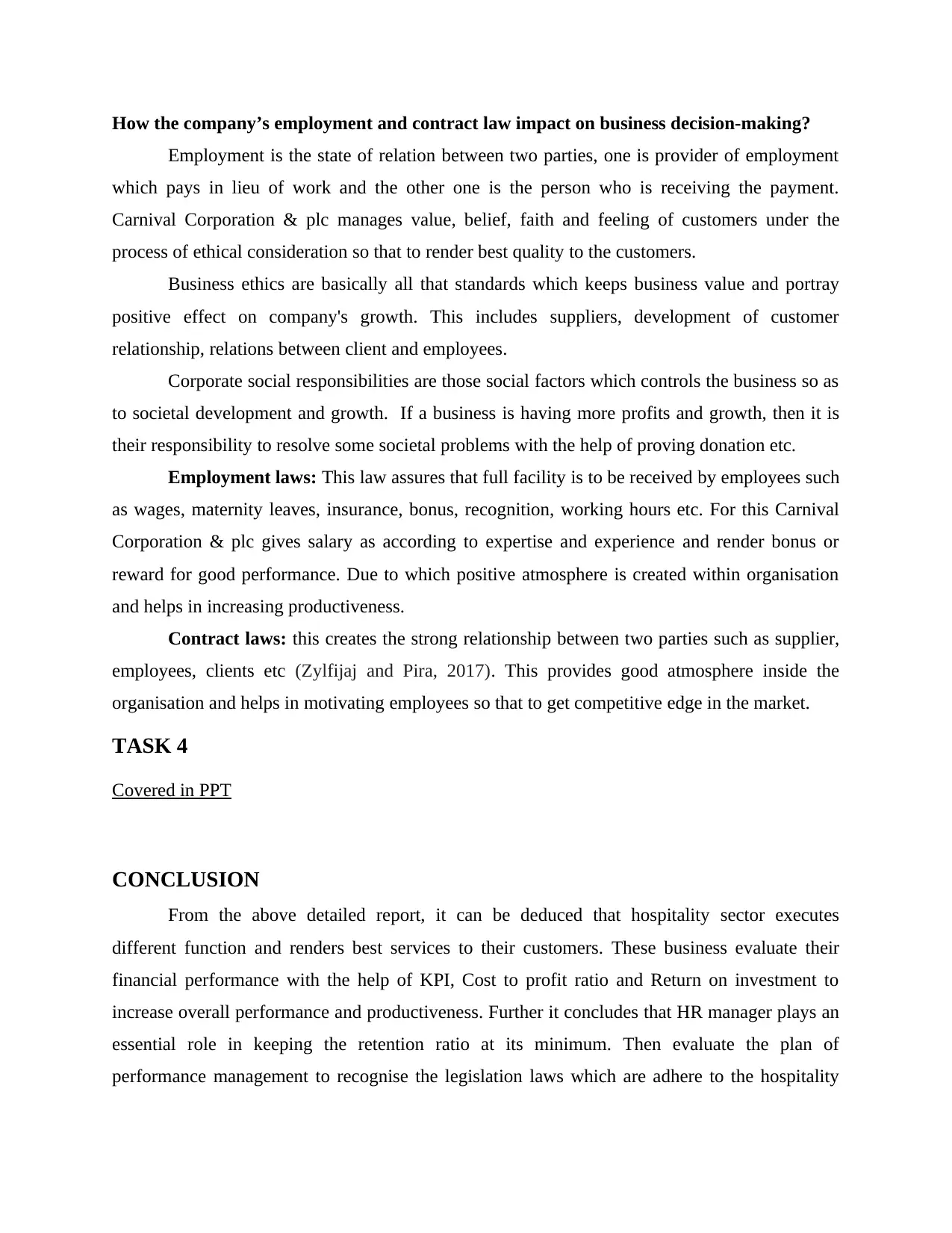
How the company’s employment and contract law impact on business decision-making?
Employment is the state of relation between two parties, one is provider of employment
which pays in lieu of work and the other one is the person who is receiving the payment.
Carnival Corporation & plc manages value, belief, faith and feeling of customers under the
process of ethical consideration so that to render best quality to the customers.
Business ethics are basically all that standards which keeps business value and portray
positive effect on company's growth. This includes suppliers, development of customer
relationship, relations between client and employees.
Corporate social responsibilities are those social factors which controls the business so as
to societal development and growth. If a business is having more profits and growth, then it is
their responsibility to resolve some societal problems with the help of proving donation etc.
Employment laws: This law assures that full facility is to be received by employees such
as wages, maternity leaves, insurance, bonus, recognition, working hours etc. For this Carnival
Corporation & plc gives salary as according to expertise and experience and render bonus or
reward for good performance. Due to which positive atmosphere is created within organisation
and helps in increasing productiveness.
Contract laws: this creates the strong relationship between two parties such as supplier,
employees, clients etc (Zylfijaj and Pira, 2017). This provides good atmosphere inside the
organisation and helps in motivating employees so that to get competitive edge in the market.
TASK 4
Covered in PPT
CONCLUSION
From the above detailed report, it can be deduced that hospitality sector executes
different function and renders best services to their customers. These business evaluate their
financial performance with the help of KPI, Cost to profit ratio and Return on investment to
increase overall performance and productiveness. Further it concludes that HR manager plays an
essential role in keeping the retention ratio at its minimum. Then evaluate the plan of
performance management to recognise the legislation laws which are adhere to the hospitality
Employment is the state of relation between two parties, one is provider of employment
which pays in lieu of work and the other one is the person who is receiving the payment.
Carnival Corporation & plc manages value, belief, faith and feeling of customers under the
process of ethical consideration so that to render best quality to the customers.
Business ethics are basically all that standards which keeps business value and portray
positive effect on company's growth. This includes suppliers, development of customer
relationship, relations between client and employees.
Corporate social responsibilities are those social factors which controls the business so as
to societal development and growth. If a business is having more profits and growth, then it is
their responsibility to resolve some societal problems with the help of proving donation etc.
Employment laws: This law assures that full facility is to be received by employees such
as wages, maternity leaves, insurance, bonus, recognition, working hours etc. For this Carnival
Corporation & plc gives salary as according to expertise and experience and render bonus or
reward for good performance. Due to which positive atmosphere is created within organisation
and helps in increasing productiveness.
Contract laws: this creates the strong relationship between two parties such as supplier,
employees, clients etc (Zylfijaj and Pira, 2017). This provides good atmosphere inside the
organisation and helps in motivating employees so that to get competitive edge in the market.
TASK 4
Covered in PPT
CONCLUSION
From the above detailed report, it can be deduced that hospitality sector executes
different function and renders best services to their customers. These business evaluate their
financial performance with the help of KPI, Cost to profit ratio and Return on investment to
increase overall performance and productiveness. Further it concludes that HR manager plays an
essential role in keeping the retention ratio at its minimum. Then evaluate the plan of
performance management to recognise the legislation laws which are adhere to the hospitality
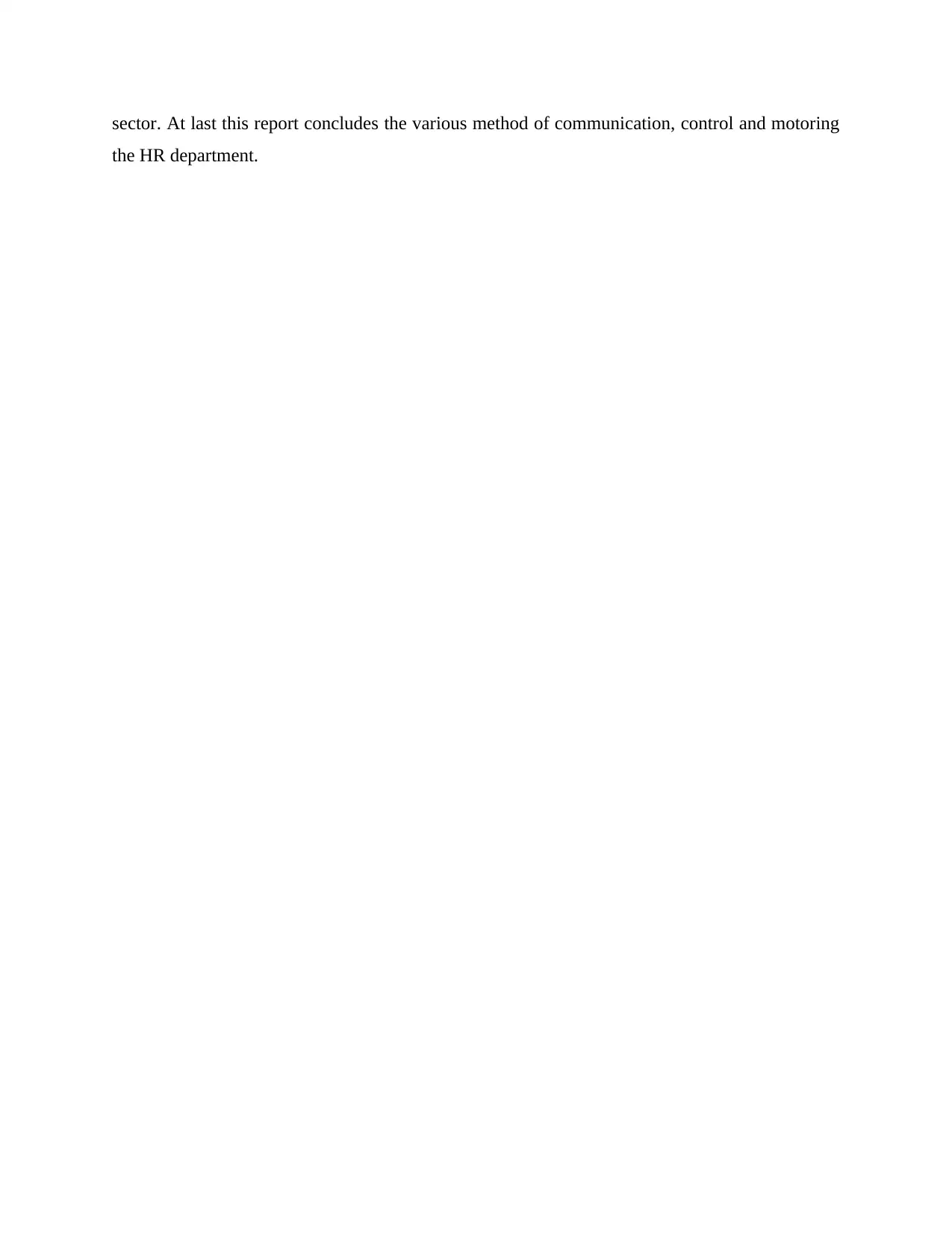
sector. At last this report concludes the various method of communication, control and motoring
the HR department.
the HR department.
⊘ This is a preview!⊘
Do you want full access?
Subscribe today to unlock all pages.

Trusted by 1+ million students worldwide
1 out of 13
Related Documents
Your All-in-One AI-Powered Toolkit for Academic Success.
+13062052269
info@desklib.com
Available 24*7 on WhatsApp / Email
![[object Object]](/_next/static/media/star-bottom.7253800d.svg)
Unlock your academic potential
Copyright © 2020–2025 A2Z Services. All Rights Reserved. Developed and managed by ZUCOL.




